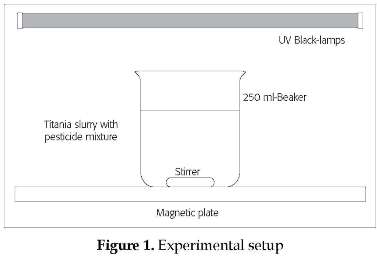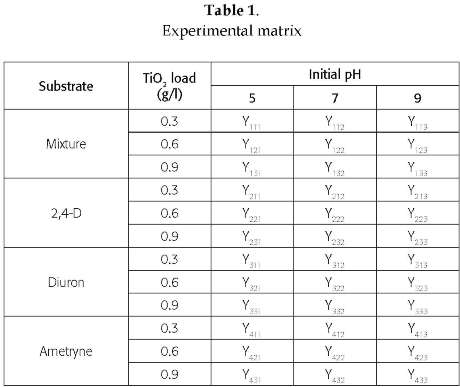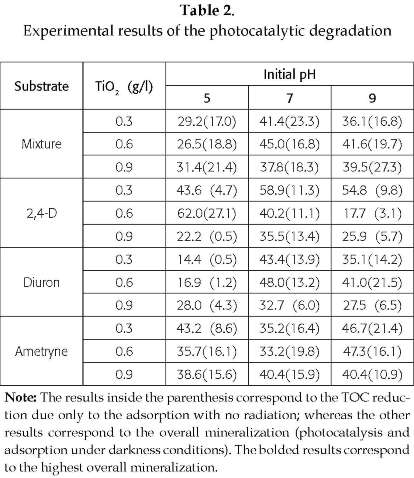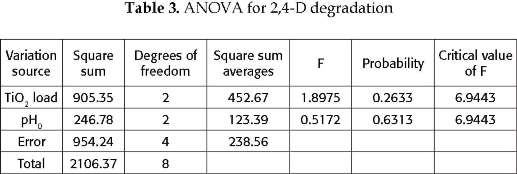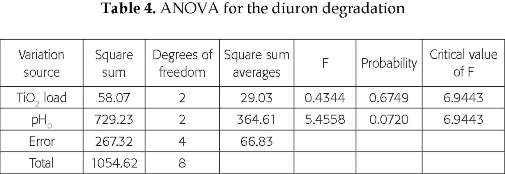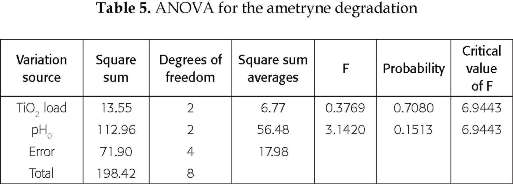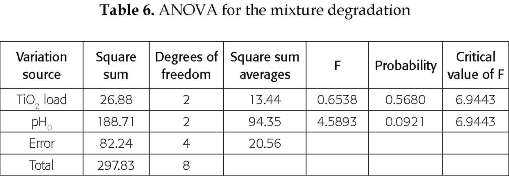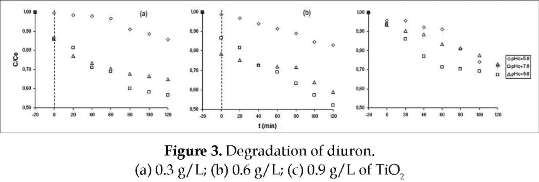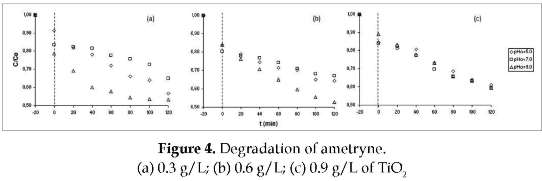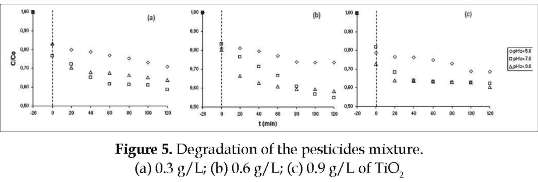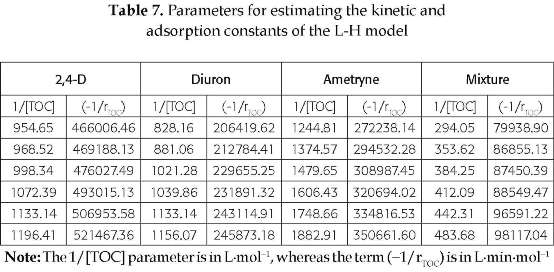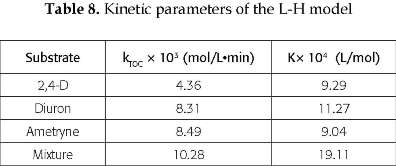Services on Demand
Journal
Article
Indicators
-
 Cited by SciELO
Cited by SciELO -
 Access statistics
Access statistics
Related links
-
 Cited by Google
Cited by Google -
 Similars in
SciELO
Similars in
SciELO -
 Similars in Google
Similars in Google
Share
Ingeniería y Desarrollo
Print version ISSN 0122-3461On-line version ISSN 2145-9371
Ing. Desarro. vol.29 no.1 Barranquilla Jan./June 2011
ARTÍCULO DE INVESTIGACIÓN / RESEARCH ARTICLE
Effect of the initial pH and the catalyst concentration on TiO2-based photocatalytic degradation of three commercial pesticides
Efecto del pH inicial y la concentración del catalizador en la fotodegradación de tres pesticidas comerciales
Fiderman Machuca-Martínez*
Universidad del Valle, Colombia
José Ángel Colina-Márquez**
Universidad de Cartagena, Colombia
* Doctor en Ingeniería Química, Universidad Industrial de Santander. Profesor asistente. Escuela de Ingeniería Química, Universidad del Valle, Grupo de Investigación GAOX, Cali ; Colombia. fiderman.machuca@correounivalle.edu.co.
**Doctor en Ingeniería. Universidad del Valle. Profesor auxiliar. Programa de Ingeniería Química, Universidad de Cartagena Sede Piedra de Bolívar, Cartagena, Colombia, jcolinam@unicartagena.edu.co.
Correspondencia: José Ángel Colina-Márquez, Universidad de Cartagena sede Piedra de Bolívar, Cartagena, Colombia, jcolinam@unicartagena.edu.co. Tel: (5)-6752040. Grants and support: Colciencias Grant No. 1106-479-22029.
Fecha de recepción: 24 de febrero de 2010
Fecha de aceptación: 17 de enero de 2011
Abstract
The photocatalytic degradations of three pesticides: 2,4-D, diuron, ametryne and a specific mixture of these ones, were carried out in a lab-scale reactor with artificial ultraviolet radiation. The effects of initial pH and catalyst concentration for each substrate were analyzed, and the degradation kinetics was modeled at the optimal operating conditions for each mineralization process. The parameters of the Langmuir-Hinselwood models fitted satisfactorily to the experimental data. The incidence of the studied variable was evaluated by analysis of variance (ANOVA). The catalyst concentration was the most important variable for the 2,4-D degradation, whereas for diuron, ametryne and the considered mixture was the initial pH. The degradations of the pesticides mixture were favored at an initial pH of 7 and 0.6 g/L of TiO2 concentration.
Keywords: Heterogeneous photocatalysis, mineralization, Langmuir-Hinshelwood.
Resumen
En este trabajo se evaluó la degradación fotocatalítica de tres pesticidas y su mezcla: 2,4 D, diurón y ametrina, en un reactor a escala de laboratorio con luz ultravioleta artificial. Se estudiaron los efectos del pH inicial y la concentración del catalizador y se modeló la cinética en las mejores condiciones de degradación para cada sustrato empleado en este estudio. Se calcularon las constantes cinéticas y de adsorción de Langmuir-Hinselwood por ajuste de parámetros. Por otro lado, se evaluó el efecto de cada una de las variables mediante un análisis de varianza. Se encontró que la variable más importante para la degradación del 2,4-D, fue la concentración del catalizador; mientras que para el diuron, la ametrina y la mezcla fue el pH inicial de la suspensión. La degradación de la mezcla se favoreció con un pH inicial de 7 y una concentración de catalizador de 0.6 g/L.
Palabras clave: Fotocatálisis heterogénea, mineralización, Langmuir-Hinselwood.
1. INTRODUCTION
Heterogeneous photocatalysis is an advanced oxidation process (AOP) which is able to destroy an ample variety of organic compounds by using powerful oxidant species. Pesticides are the pollutants most often treated by this process. These compounds are used in the crops for the elimination of weeds and plagues and their chemical structures become in very persistent substances in all the environmental compartments [1] .
Most of pesticides are not treatable by biological systems and it is necessary to look for more efficient and environment-friendly alternatives. Heterogeneous photocatalysis has been successfully used for treating these pollutants at laboratory, pilot and even industrial-scale [2-6] . The advantages of this technology are the following: non-toxic and low cost catalyst, the solar energy can be used for promoting the oxidation reactions, and the pollutants can be totally mineralized.
Although there are many pesticides, they have been classified in families according to their main active functional groups; so, the results obtained with other commercial brands can be used as valid references. The diuron, for example, has been degraded in presence of suspended and supported titanium dioxide [7] for comparing the performance of each catalyst. In addition, the photodegradation kinetics of some sulphonylureas (diuron belongs to this family of pesticides) has been studied [8-12] and several first-order and second-order kinetic expressions were found. For the 2,4-D, there are similar studies where the catalyst performances (slurry and supported) were compared [13-15] . For this pesticide, zero-order kinetic expressions were found in experiments with artificial and solar UV radiation [15] ; and also, the effects of the pH, oxygen concentration and some metallic cations presence in water were analyzed. In the case of the ametryne, the effect of the pH on the adsorption of this pesticide in soils has been studied [16] due to considerable amounts of ametryne detected after its use on diverse crops.
In the present work, the effects of the initial pH and the TiO2 concentration (in slurry) on the degradation of three commercial pesticides were studied. The experimental tests were carried out with the separated pesticides and a specific mixture similar to the one used in the Colombian sugar cane crops. Artificial UV radiation as photons' source for promoting the photocatalytic reactions was used and the kinetics parameters of the Langmuir-Hinselwood (L-H) model were also estimated at the operating conditions that maximized the mineralization of the pollutants. The kinetic constants found in this study were apparent or non-intrinsic since the photonic component was masked in these constants.
2. EXPERIMENTAL PROCEDURE
Materials and methods
The commercial pesticides used for these experiments: Karmex® (diuron, 80% w/w), Igram® (ametryne) and Profiamina® (2,4-D as a dimethylamine salt with a concentration of 720 g/L). Deionizated water was used to prepare the solutions for the photocatalytic treatment. In addition, the additives Cosmoaguas® and Inex-A® were used in the preparation to simulate the composition of the mixture for the sugar cane crops. The catalyst was the Aeroxide P-25® supplied by Degussa and the initial pH of each solution was adjusted with HCl and NaOH (both with 0.1 M of concentration).
The lab-scale photoreactor was built with a metallic box (90 cm x 40 cm x 30 cm) and a set of five UV black lamps Phillips TLD® with a nominal output power of 18W each one (as seen in Figure 1). For the reactor vessels, a set of six 500 ml-beakers were used. The slurries were kept homogenized with a magnetic stirring plate Variomag®. The measurement devices used for the tests were: Shimadzu 5050 TOC analyzer and a pH meter Accumet® AB15.
Experimental design
For this study, a full-composite design was established as shown in Table 1, considering the initial pH and the catalyst load as the main effects.
The response variable Y..kof this design was the mineralization percentage achieved by the degradation process that was calculated as the proportion of the TOC content degraded by photocatalysis, according to Eq. 1:

The aim of this experimental design was to find the operating conditions that maximized the overall mineralization of the substrate. For each treated substrate, it was possible to find such conditions, and they were used for adjusting the L-H kinetic parameters as seen in Eq. 2:

Where kTOCcorresponds to the non-intrinsic kinetic constant since this one masked the photon adsorption rate effect; and K is the adsorption constant typical of the processes that imply a solid-liquid interface. The estimation of these parameters was possible with linear regression obtained from a minimum squares analysis of the L-H linear expression (Eq. 3):

Procedure
The stock solution of the commercial pesticides was prepared with 1 L of distilled water and this mixture composition: 16.7 g of Karmex®, 10 ml of Profiamina®, 20 ml of Igram®, 0.7 g of Cosmoaguas®, and 1 ml of Inex-A®. The working solution was prepared from the stock solution by diluting 0.88 of the stock solution in 1 L of distilled water. This dilution was used for each separated pesticide treatment and 400 ml of this dilution was used for the experimental tests with the amount of catalyst specified by the experimental design proposed. The adsorption equilibrium was achieved by continuous stirring with no irradiation during 20 min and the first sample was taken before beginning the stirring. Then, the initial pH was adjusted with HCl or NaOH as needed. Once the UV lamps were turned on, the second sample was taken at the start and every 20 min during the two hours of the experimental run. The TOC content was measured for all the samples.
3. RESULTS AND DISCUSSION
Effect of the initial pH and the catalyst concentration
The TOC reduction percentages obtained in the darkness period due to the adsorption phenomenon and due to the overall mineralization were listed in Table 2. The initial concentrations of each substrate (measured as TOC) were as follows: 2,4-D, 12.63 ppm; diuron, 16.7 ppm; ametryne, 11.49 ppm; and the pesticides mixture, 40.81 ppm. It can be noted that the adsorption phenomenon influenced on the overall mineralization and this effect depended on the operating conditions and the substrate type.
From the listed results, the best operating conditions to reduce the TOC content were as follows: for the 2,4-D, initial pH of 5 and 0.6 g/L of catalyst concentration; for the diuron, initial pH of 7, and 0.6 g/L; for the ametryne, initial pH of 9 and 0.6 g/l; and for the mixture of pesticides, pH 7 and 0.6 g/L. In all the cases, the results regarding the pH were consistent with the ones reported in previous works [2, 7-10] . Konstantinou and Albanis [17] made a review of the degradation mechanisms and the intermediates produced by the TiO2-based photocatalysis of several pesticides families. In this work, it was established that the degradation of the 2,4-D was favored by an acidic pH; whereas for the diuron, the mineralization was faster in a neutral medium and the ametryne degraded better in an alkaline one. The pH effect determines the specific attack of the oxidant species to certain parts of the chemical structure of the substrate. Also, the pH determines the electric charge on the catalyst surface, and therefore, the type of compounds that can be adsorbed by the solid catalyst. The pH of zero charge (pHzpc) reported for the Degussa P-25 is 6.25 [2] , which means that pH values greater than this one, the catalyst surface will be negatively charged due to the greater presence of •OH and if the pH is less than this value of zero charge, the opposite will occur (predominant presence of H+).
The intermediates produced by the photocatalytic degradation of the 2,4-D can be considered as cationic, since with a initial pH of 5 and 0.6 g/L of catalyst load, the TOC adsorbed was 27.1% with an overall mineralization of 62%. The adsorption of these intermediates could decrease considerably with an increase of the initial pH due to their anionic nature; whereas the adsorption of the diuron was improved with larger initial pH values, achieving the largest TOC adsorption (21.5%) with an initial pH of 9. The same occurred to the ametryne (21.4%), which means that the degradation intermediates of these pesticides were cationic; nonetheless, the diuron degraded better at pH 7, according to the results reported in literature [17] . The hydroxyl free radicals attack to the ring structure as well the side chains of the diuron in neutral medium and this set of mechanisms of degradation was the dominant stage of this compound mineralization. Whereas for the 2,4-D and the ametryne, the adsorption affected more significantly the overall mineralization of these two substances due to the cationic nature of their intermediates.
The behavior of the degradation of the mixture was similar to the one observed for the diuron, it means that the degradation was favored by a pH of 7. This is an evidence of the predominance of cationic species in the mineralization process; but in the same way, the photocatalytic degradation reactions developed in a neutral medium were more significant in the overall TOC reduction of the pesticides mixture. Although the highest degradation for the separated compounds was 62%, the maximum degradation for the mixture was 45%. The TOC reduction of the mixture was slower than the separated compunds' one since the substrates in the mixture compete not only for the active sites of the catalyst surface, but as well as for the available oxidant species. The other reason is the larger TOC concentration and it is well known that the substrate initial concentration can limit the photoca-talytic mineralization rate [18] . This behavior has been observed in similar previous studies, not only for heterogeneous photocatalytic treatment, but for the Photo-Fenton process applications [3,19-21] .
Regarding the catalyst load effect, it influenced the ability to generate oxidant species, which was limited by the optical properties of the whole reactive system. Thus, the effect of the catalyst load was more related to the optical properties of the substrate and the reactor than the chemical characteristics of the substances present in the reaction [22,23] .
The spatial distribution of the photons inside the reactor depends on the absorptivity and the dispersion coefficient associated to the catalyst load [24] and the radiation availability. These features make that the catalyst load can be increased limitlessly without affecting the degradation process performance, as seen in the results shown in Table 2. The catalyst load which presented the highest overall TOC reductions was 0.6 g/L for all the cases studied. With larger loads (for example, 0.9 g/L), the TOC degradation decreased considerably due to a more evident negative effect of a larger photon dispersion.
Statistical analysis (ANOVA)
The results of the analysis of variance for each pesticide and the mixture are listed in tables 3-6. For the 2,4-D, although both effects were significant, the catalyst load was the most relevant in the 2,4-D photodegradation. Thus, this process was more sensitive to the catalyst load but the optical properties of the substrate did not influence the overall photocatalytic mineralization (see Table 3).
For the diuron, the initial pH effect was the most relevant as shown in Table 4. As it was mentioned before, the selectivity of the attack of the hydroxyl free radicals was determined by the pH. In addition, the diuron could contribute to photon dispersion making the photocatalytic process less sensitive to changes in the catalyst load
For the ametryne, the observed results were very similar to the ones obtained with the diuron, but with smaller variances (see Table 5). The most incident effect was the initial pH; nonetheless, the mechanisms of degradation of the ametryne are very different since the oxidative attack is not dominated by the pH, in addition to a reductive phase present in photodegradation of this compound [17] . Similar to the diuron case, the ametryne could also contribute to a photon dispersion that made the photocatalytic process less sensitive to catalyst load changes.
Finally, for the mixture, the results were very similar to the ones observed in the two previous analyses (diuron and ametryne). The most incident effect was still the initial pH of the slurry (see Table 6).
This indicates that the photodegradation behavior was dominated by the presence of the diuron and the ametryne. It is probable that the diuron was the degradation rate-limiting compound since the best mineralization was obtained at a pH of 7, which is the same condition that increased the diuron mineralization. In this way, the determining phase of the TOC reduction rate of the mixture would be the attack of the »OH free radicals to the diuron and ametryne's rings since they are the most difficult structures to break.
Kinetics analysis
The study of the degradation rate laws was carried out under the conditions which maximized the TOC reduction for each substrate; initial pH of 5 for 2,4-D, 7 for diuron and the mixture and 9 for the ametryne. The catalyst concentration was 0.6 g/L for all the substrates.
Figures 2-5 show the experimental data obtained for the kinetic study of the photocatalytic of each substrate. As it was discussed before, the behavior of the mixture degradation was very similar to the ones observed with the ametryne and the diuron.
This confirmed the results obtained from the analyses of variance for each substrate. Nonetheless, the degradation rate of the mixture was slightly lower than the separated pesticides. This was a clear evidence of the competence between the substrates and how this affected negatively to the photocatalytic degradation rate [18] .
For the estimation of the kinetic and adsorption parameters of the L-H model for each substrate, the optimal conditions for the corresponding degradations were considered. It was necessary to use the linear form of the L-H expressed as shown in Eq. 3. Table 7 shows the data used for this model fitting.
The parameters were adjusted by using the experimental data corresponding to the photocatalytic process only, which means that the darkness period was not considered for these calculations. The R2 fitting parameter was satisfactory for all the linear regressions. For the 2,4-D and the ametryne was 0.99, whereas for the mixture and the diuron was 0.94.
The kinetic and adsorption parameters of the L-H model (Eq. 2) were adjusted to the experimental data and listed in Table 8:
The kinetic constants kTOCfound are apparent or non-intrinsic since the effect of the rate of photon absorption are masked in these values. Also, the TOC is a global parameter that involves the primary compounds and the intermediates; and in this way, the kinetic constants resulted very similar. The overall mineralization rate for each substrate was limited by the adsorption phenomenon, especially in the darkness period. These results are congruent to the ones listed in Table 2. For the 2,4-D, for example, the 27% of the initial TOC content was adsorbed after 20 min of darkness with an initial pH = 5.
The L-H model described satisfactorily the kinetics of the mixture degradation. The fitting was better at higher initial TOC concentrations; nonetheless, the L-H model was validated to describe heterogenous photocatalytic degradation as reported in previous works [17,18,25] . In the case of the 2,4-D, zero-order kinetic expressions have been reported [15] (very fast adsorption and non-limiting for the overall reaction rate), although the conditions reported in the referred study were: very good photonic availability and an initial concentration of the substrate much lower than the one used in our study.
4. CONCLUSIONS
The photocatalytic degradation of the commercial pesticides considered for this study was more influenced by the initial pH of the slurry than the catalyst load. Only for the 2,4-D, the observed behavior was the opposite. The initial pH influenced strongly on the physical adsorption phenomenon and it was determining on the overall mineralization of the substrates. The mineralization kinetics of the mixture was fitted to the L-H model, which showed how the adsorption phenomenon was significant in the photocatalytic degradation rate. This was more evident for the ametryne and the mixture cases which exhibited the smallest adsorption constants.
Acknolewdgements
The authors thank the Ch. Engs. David Muñoz and Oscar Rogeles by carrying out the experimental work. Also, the authors give a special acknowledgement to Colciencias (Programa de Apoyo a Doctorados Nacionales) for the financial support for their Ph.D. studies.
References
[1] S. Malato, J. Blanco, C. Estrada, E. Bandala. "Degradación de plaguicidas" in: Eliminación de contaminantes por Fotocatálisis Heterogénea. M. B., editor. CYTED, 2001. [ Links ]
[2] S. Kamble, S. Sawant, V. Pangarkar. "Photocatalytic mineralization of phenoxyacetic acid using concentrated solar radiation and titanium dioxide in slurry photoreactor". Chemical Engineering Research and Design, vol. 84, no.A5, pp.355-362, 2006. [ Links ]
[3] S. Malato, J. Blanco, C. Richter, B. Milow, M. Maldonado. "Preindustrial experience in solar photocatalytic mineralization of real wastewaters: Application to pesticide container recycling". Water Science and Technology, vol. 40, no.4-5, pp.123-130, 1999. [ Links ]
[4] S. Malato, J. Blanco, A. Vidal, C. Richter. "Photocatalysis with solar energy at a pilot-plant scale: An overview". Applied Catalysis B: Environmental, vol. 37, pp.1-15, 2002. [ Links ]
[5] S. Malato, J. Blanco, J. Cáceres, A.R. Fernández-Alba, A. Agüera, A. Rodríguez. "Photocatalytic treatment of water-soluble pesticides by photo-Fenton and TiO2 using solar energy". Catalysis Today, vol. 76, pp.209-220, 2002. [ Links ]
[6] Malato S., Maldonado R., Blanco J. Descontaminación de aguas de lavado de plaguicidas mediante fotocatálisis solar. 1era ed. Madrid: CIEMAT; 2008. [ Links ]
[7] M. El Madani, C. Guillard, N. Pérol, J.M. Chovelon, M. El Azzouzzi, A. Zrineh, et al. "Photocatalytic degradation of diuron in aqueous solution in presence of two industrial titania catalysts, either as suspended powders or deposited on flexible industrial photoresistant papers". Applied Catalysis B: Environmental, vol. 65, pp.70-76, 2006. [ Links ]
[8] M. Farré, S. Brosillon, X. Domenech, J. Peral. "Evaluation of the intermediates generated during the degradation of Diuron and Linuron herbicides by the photo-Fenton reaction". Journal of Photochemistry and Photobiology A: Chemistry, vol. 189, pp.364-373, 2007. [ Links ]
[9] M. Farré, M. Maldonado, W. Gernjak, I. Oller, S. Malato , X. Domenech, et al. "Coupled solar photo-Fenton and biological treatment for the degradation of diuron and linuron herbicides at pilot scale". Chemosphere, vol. 72, no.4, pp.622-629, 2008. [ Links ]
[10] H. Katsumata, M. Sada, N. Yusuke, S. Kaneco, T. Suzuki, K. Ohta. "Photocatalytic degradation of diuron in aqueous solution by platinized TiO2". Journal of Hazardous Materials, vol. 171, no.1-3, pp.1081-1087, 2009. [ Links ]
[11] W. Paterlini, R. Pupo-Nogueira. "Multivariate analysis of photo-Fenton degradationof the herbicides tebuthiuron, diuron and 2,4-D". Chemosphere, vol. 58, pp.1107-1116, 2005. [ Links ]
[12] E. Vulliet, C. Emmelin, J.M. Chovelon, C. Guillard, J.M. Herrmann. "Photocatalytic degradation of sulfonylurea herbicides in aqeous TiO2". Applied Catalysis B: Environmental, vol. 38, pp.127-137, 2002. [ Links ]
[13] U. Gaya, A. Abdullah. "Heterogeneous photocatalytic degradation of organic contaminants over titanium dioxide: A review of fundamentals, progress and problems.". Journal of Photochemistry and Photobiology C: Photochemistry Reviews, vol. 9, no.1, pp.1-12, 2008. [ Links ]
[14] J.M. Herrmann, J. Disdier, P. Pichat, S. Malato , J. Blanco. "TiO2-based solar photocatalytic detoxification of water containing organic pollutants. Case studies of 2,4-dichlorophenoxyaceticacid (2,4-D) and of benzofuran". Applied Catalysis B: Environmental, vol. 17, no.1-2, pp.15-23, 1998. [ Links ]
[15] S. Kundu, A. Pal, A. Dikshit. "UV induced degradation of herbicide 2,4-D: kinetics, mechanism and effect of various conditions on the degradation". Separation and Purification Technology, vol. 44, no.2, pp.121-129, 2005. [ Links ]
[16] G. Sheng, Y. Yang, M. Huang, K. Yang. "Influence of pH on pesticide sorption by soil containing wheat residue-derived char". Environmental Pollution, vol. 134, no.3, pp.457-463, 2005. [ Links ]
[17] K. Konstantinou, T. Albanis. "Degradation pathways and intermediates of photocatalytic transformation of major pesticide groups in aqeous TiO2 suspensions using artificial and solar light: A review". Applied Catalysis B: Environmental, vol. 42, pp.319-335, 2003. [ Links ]
[18] G. Li Puma, B. Toepfer, V. Puddu. "Photocatalytic oxidation of herbicides in single-component and multicomponent systems: Reaction kinetics analysis". Applied Catalysis B: Environmental, vol. 65, pp.1-10, 2006. [ Links ]
[19] M. Ballesteros, M. Sánchez-Pérez, J. Casas-López, I. Oller, S. Malato. "Degradation of a four-pesticide mixture by combined photo-Fenton and biological oxidation". Water Research, vol. 43, pp.663-670, 2009. [ Links ]
[20] L. Lhomme, S. Brosillon, D. Wolbert. "Photocatalytic degradation of pesticides in pure water and a commercial agricultural solution on TiO2 coated media". Chemosphere, vol. 70, pp.381-386, 2008. [ Links ]
[21] A. Zapata, I. Oller, F. Bizani, M. Sánchez-Pérez, M. Maldonado, S. Malato. "Evaluation of operational parameters involved in solar photo-Fenton degradation of a commercial pesticide mixture". Catalysis Today, vol. 144, no.1-2, pp.94-99, 2009. [ Links ]
[22] A. Cassano, O. Alfano, R. Brandi, C. Martin. "Diseño de reactores para fotocatálisis: conceptos fundamentales" in: Eliminación de contaminantes por Fotocatálisis Heterogénea. M. B., editor. CYTED, 2001. [ Links ]
[23] J. Giménez, D. Curcó. "Modelos Cinéticos y de radiación en sistemas fotocatalíticos" in: Eliminación de Contaminantes por Fotocatálisis Heterogénea. M. B., editor. CYTED, 2001. pp. 189. [ Links ]
[24] M. Satuf, R. Brandi, A. Cassano, O. Alfano. "Experimental method to evaluate the optical properties of aqueous titanium dioxide suspensions". Industrial and Engineering Chemistry Research, vol. 44, no.17, pp.6643-6649, 2005. [ Links ]
[25] K. Tanaka, K. Reddy. "Photodegradation of phenoxyacetic acid and carbamate pesticides on TiO2". Applied Catalysis B: Environmental, vol. 39, pp.305-310, 2002. [ Links ]













